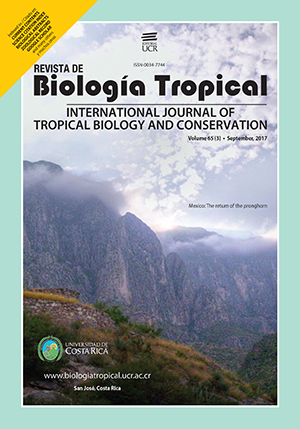Abstract
The reintroduction of missing mammal species in former habitats has recently been of high interest. In Mexico, there have been several attempts to reintroduce Antilocapra since 1967, but until now none of the trials has been successful. Nowadays, different releasing methods have been practiced for mammal species, including soft and hard release ones. The aim of this study was to provide new information, and to evaluate the success of a recent release. The study was based on the monitoring of 100 individuals (70 females, 30 males) captured in New Mexico, USA, to be released in Maderas del Carmen, Coahuila, Mexico, in two different groups. The first group (fast release) of 45 specimens (20 females, 25 males) was released in the valley at the beginning of March 2009. The second one (soft release), with 55 individuals (50 female, 5 male), was released in March 2010. For both groups, we compared the mortality rate between dispersal and soft-release vs. hard-release methods. Our results showed that the release with adaptation gave highly significant results (χ2= 2, α= 0.05, p= 0.0001)). The comparison of mortality and dispersion among both methods was highly contrasting: with soft-release we obtained 4 % and 13 % of success, against 23 % and 46 %, respectively. Considering these results, we recommend the soft-release method to be used in future reintroduction attempts of Antilocapra, since more than 50 % of specimens from hard-releases died because of capture stress, or were dispersed, and thus reduced the reintroduction success chances.
References
Baker, R. H. (1956). Mammals of Coahuila Mexico. Kansas, E.U.A.: Museum of Natural History.
Baker, R. H. (1958). The future of wildlife in northern Mexico a problem in conservation education. Transactions of the 23rd North American Wildlife Conference, 23, 567-575.
Cancino, J. (2005). Familia Antilocapridae, Berrendo. En G. Ceballos & O. Giselle (Eds.), Los Mamíferos silvestres de México (pp. 502-504). México, D.F., México: Comisión Nacional para el Conocimiento y Uso de la Biodiversidad.
Convención sobre el Comercio Internacional de Especies Amenazadas de Fauna y Flora Silvestres. (2010). Apéndices. Recuperado de https://cites.org/esp/app/index.php
Eastridge, R., & Clark, J. D. (2001). Evaluation of 2 soft release techniques to reintroduce black bears. Wildlife Society Bulletin, 29(4), 1163.
Fatooh, J., Russi, T., & Goldsmith A. (1994). Pronghorn reintroduction to Mono County, California: 12 years after. Pronghorn Antelope Workshop, 16, 35-49.
Fisher, L. W. (1942). Live tramping Texas antelopes. Journal Wildlife Management, 6, 231-236.
Gibert, S. (2007). Dinámica poblacional y preferencia de hábitat de un grupo de wapitíes (Cervus elaphus) reintroducido en la Sierra Maderas del Carmen (Tesis de Maestría). U.A.N.L., Linares, México.
González, A. & Lafón, A. (1993). Distribución y estado actual del berrendo (Antilocapra americana) en México. En R. A. Medellín & G. Ceballos (Eds.), Avances en el estudio de los mamíferos de México (pp. 409-420). México D.F., México: Asociación Mexicana de Mastología, A.C.
Unión Internacional para la Conservación de la Naturaleza (2010). Red List of threatened species. Recuperado de www.iucnredlist.org
Koch, A., & Yoakum, J. (2002). Reintroduction and status of pronghorn on the Carrizo Plain National Monument and surrounding areas in southern. Pronghorn Antelope Workshop, 20, 25-41.
Leopold, A. (1959). Fauna Silvestre de México Aves y Mamíferos de Caza. México D. F., México: Instituto Mexicano de Recursos Renovables.
Martínez, L. (2009). Site fidelity and post release movements of translocated mule deer in northern Coahuila, Mexico (Tesis de Maestría). Sul Ross State University, Alpine. E.U.A.
Miranda, E. P. (2000). Monitoreo de una población de berrendo (Antilocapra americana mexicana) reintroducida el noroeste de Coahuila. (Tesis Maestría). U.A.N.L. Linares, México.
Nelson, E. W. (1927). Status of Pronghorned antilope. 1922-1924. U.S. Departament Agriculture Bulletin, 1346, 1-66.
Nielson, L. (1988). Definitions, considerations, and guidelines for translocation of wild animals, En L. Nielsen & R. D. Brown (Eds.), Translocation of wild animals (pp 12-52). Kingsville, E.U.A.: Caesar and Kleberg Wildlife Research Institute.
Secretaría de Medio Ambiente y Recursos Naturales y Pesqueros [SEMARNAP]. (1997). Programa de Manejo del Área de Protección de Flora y Fauna Maderas del Carmen, Coahuila, México. México D.F., México: Instituto Nacional de Ecología.
Secretaría del Medio Ambiente y Recursos Naturales Pesqueros [SEMARNAP]. (2010). Norma Oficial Mexicana NOM-059-SEMARNAT-2010 Diario Oficial de la Federación. Recuperado de http://www.profepa.gob.mx/innovaportal/file/435/1/NOM_059_SEMARNAT_2010.pdf
Secretaría de Medio Ambiente y Recursos Terrestres [SEMARNAT]. (2009). Programa de acción para la conservación de la especie: Berrendo (Antilocapra americana). México D.F., México: Comisión Nacional de Áreas Naturales Protegidas.
O’Gara, B., & Yoakum, J. (2004). Pronghorn Ecology and Management. Boulder, E.U.A.: University Press of Colorado.
Porter, B. (2006). Evaluation of collared peccary translocations in the Texas Hill Country (Tesis Maestría). Texas A&M University, Kingsville, E.U.A.
Valdéz, M. & Manterola, C. (2006). Reintroducción del berrendo en Coahuila. En M. Valdéz, E. Peters, & E. Palledares (Eds.), El berrendo en México acciones de conservación (pp. 97-111). México, D. F., México: Agrupación Sierra Madre.
Woolley, T. P., & Lindzey, F. G. (1994). Relative precision and sources of bias in pronghorn sex and age composition surveys. Journal Wildlife Management, 61(1), 57-63.
##plugins.facebook.comentarios##

This work is licensed under a Creative Commons Attribution 4.0 International License.
Copyright (c) 2017 Revista de Biología Tropical






